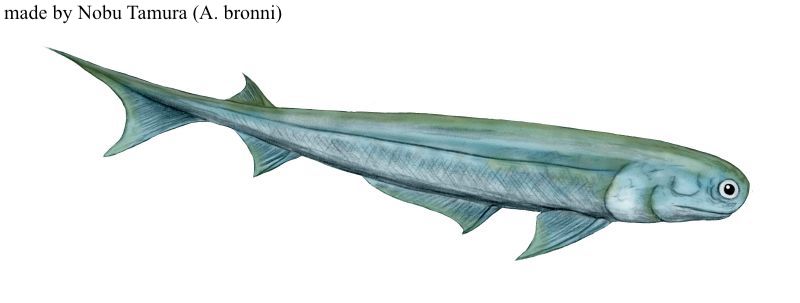Welcome to Acanthodes

Name Definition
Spiny/thorny base
Name Given By
Agassiz in 1833
Location
Fossils of Acanthodes have been found in Europe, North America, Asia, and Australia, suggesting a worldwide geographical range
Classification
Chordata, Gnathostomata, Acanthodii, Acanthodiformes
Size
Around 30 cm long (12 in.)
Temporal Range
Mississippian age of the Carboniferous to the Artinskian age of the early Permian, ~358 - 284 million years ago (some species have been collected from strata as early as from the Pragian stage of the early Devonian, though their validity is being questioned)
Ecological niche
Small filter feeder
Species/Sub Species
A. bronni (type species), A. bridgei, A. gracilis, A. guizhouensis and about 20 more species
Diet
Because of the absence of teeth in Acanthodes, it is widely thought that Acanthodes was a filter feeder and fed on plankton and other small invertebrates that could fit in its mouth
Introduction
Acanthodes is a genus of extinct "spiny sharks" that radiated all across the world and lived during the Carboniferous to the Permian, and possibly also lived in the Devonian. Acanthodes means “spiny base” which is in reference to the pectoral and pelvic fins having a spine, making it look like it had a spine under its belly which is the base. Acanthodes was a successful species of fish and spread worldwide while also living for millions of years. While Acanthodes and its acanthodian relatives are often called spiny sharks, this is somewhat of a misnomer and they only look superficially similar to modern day sharks, and actually are instead thought to have been basal chondricthyans or cartilaginous fish.
Compared to its relatives, Acanthodes was large, at almost 30 cm long (12 inches), with most acanthodians not growing up to more than 25 cm, though there are some exceptions such as the Devonian Ischnacanthus that grew up to 2 meters long. Acanthodes had an edentulous mouth (no teeth), and this is interpreted by scientists as an indication that Acanthodes was instead a small filter feeder that strained plankton and other small aquatic invertebrates in its mouth. Compared to other vertebrates, Acanthodes also had relatively less bones in its skull, meaning the remaining bones of the skull would have been bigger proportionately. The scales that Acanthodes was covered in were cubical in shape. Acanthodes has less than half the amount of spines present on most other acanthodians, with paired pectoral fins (2), paired pelvic fins (2), as well as the single anal fin and the dorsal fin further on its tail, making it only have 6 spines supported by fins on the entire body. A fossil was found near Hamilton, Kansas in the late Carboniferous Hamilton Formation. This fossil was later attributed to the genus Acanthodes in 2014 and was given the name Acanthodes bridgei. A. bridgei was so well-preserved that pieces of its eye tissue were enough to tell that Acanthodes had rod and cone photoreceptor cells in its eyes, and because of the cone photoreceptors, Acanthodes most likely benefited from color vision since cone cells are sensitive to color.
There were several specimens of Acanthodes discovered from the abandoned Hamilton Quarry. The individuals discovered from the quarry ranged in sizes from 54 mm to 410 mm. Again, A. bridgei was also found at the quarry.
The scientific classification of acanthodians is still under debate as they share anatomical features with both bony fish and cartilaginous fish. A recent phylogenetic study suggests that Acanthodes may have been the common ancestor of all cartilaginous and bony fish, if not then at least closely related to the common ancestor, and this includes all tetrapods as well, as they descended from bony fish. Internal anatomy of acanthodians is best known from A. bronni since its remains are well-preserved, including what might be an osteichthyan (bony fish) braincase. Because of the mix of chondrichthyan and osteichthyan features in Acanthodes, it has become essential component to understanding basal gnathostome (jawed vertebrates) phylogenies (phylogeny is the study of evolution and diversification in different groups or taxa of organisms). Acanthodes has been considered to be quantifiably closer to chondricthyans (cartilaginous fish) than osteichthyans, however, phylogenetic analysis has classified it as an osteichthyan, which is part of a resolved phylogenetic tree that recovers acanthodians as stem chondrichthyans and stem gnathostomes. Thus, the ostensible chondricthyan features in the cranium of Acanthodes actually represent plesiomorphies (an ancestral or primitive trait in a lineage) in the crown group gnathostomes. In addition to the debate of acanthodian classification, some increasingly detailed findings of the early evolution of gnathostomes are calling attention to the ongoing efforts of reorganization of vertebrate skulls after the origin of jaws in vertebrates but before the origins of living crown groups.
Acanthodians are known to be more advanced than placoderms (a group of prehistoric armoured fish) and are thought to be close to the common ancestor of all chondrichthyans and osteichthyans. Researchers used 138 well-preserved skulls of A. bronni and have determined that acanthodians are in fact closer to chondrichthyan fish than to osteichthyan fish.
Sources:
- https://en.wikipedia.org/wiki/Acanthodes#Discovery